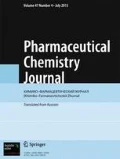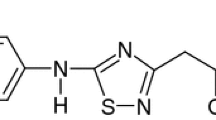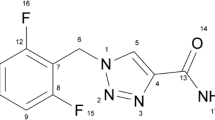The inclusion complex of the antiepileptic drug carbamazepine with hydroxypropyl-β-cyclodextrin was prepared by co-dissolution in practically quantitative yield with losses <1% to increase its solubility and bioavailability. The complex was studied by PMR spectroscopy and differential scanning calorimetry. Acomparison with initial carbamazepine and hydroxypropyl-β-cyclodextrin confirmed that the inclusion complex formed without covalent chemical bonds. The physicochemical properties of the inclusion complex were studied. Its solubility in water was determined as 5・105 mg/L (at 25°C). The anticonvulsant activity of the resulting drug form was assessed after intraperitoneal and intranasal administration to mice. The results indicated that the complex could be used effectively as an anticonvulsant agent at a dose of 20 mg/kg.
Similar content being viewed by others
The solubility and bioavailability of drugs are often two interrelated issues for designing a new effective dosage form. Carbamazepine (CBZ) or 5-carbamoyl-5H-dibenz[b, f]azepine (Fig. 1) is a widely used first-line drug for partial and generalized seizures in epilepsy patients [1]. However, CBZ is slowly and incompletely absorbed in the gastro-intestinal tract because of its extremely low water-solubility (18 mg/L at 25°C [2]). This decreases its efficacy [3].
Medicines containing CBZ are currently available on the global pharmaceutical market as tablets, capsules, and peroral suspensions. Unfortunately, a parenteral dosage form of CBZ that would be useful for rendering emergency care to epilepsy patients in comas or with impaired swallowing does not exist. Therefore, the design of a dosage form suitable for parenteral administration is a rather challenging problem.
One method for increasing the solubility of drug substances that are difficultly soluble in water is to incorporate them into inclusion complexes with cyclodextrins (CDs), which are cyclic glucose oligomers. CDs have been broadly utilized in the pharmaceutical industry because of their biocompatibility, biodegradability, safety, and ability to form host—guest inclusion complexes with many organic molecules, biologically active compounds, etc. [4]. Thus, the aim of the present work was to produce a water-soluble complex of CD with CBZ, to study its physicochemical properties, and to assess preliminarily its biological activity.
EXPERIMENTAL CHEMICAL PART
CBZ of molecular mass 236 Da (Akrikhin, Russia) meeting quality requirements of PM.2.1.0020.15 and hydroxypropyl-β-cyclodextrin (HP-β-CD) of molecular mass 1410 Da with 0.65 degree of substitution (Wuhan, China) and compendial quality EP 07/2013:1804 were used in the studies.
The inclusion complex based on them was prepared by co-dissolution [5]. For this, dry HP-β-CD (4.26 mmol) was placed into a tared conical flask to which a weighed portion of CBZ (2.12 mmol) was added. The dry components were treated with EtOH (96%) in an amount sufficient to produce 30 mass/vol% HP-β-CD. The mixture was thermostatted at 55°C on an IKA C-MAG HS 7 hot plate with constant stirring at 450 rpm for 2 h until the starting components were completely dissolved. The solution was cooled to room temperature and filtered through a previously weighed 0.22-μm membrane filter. The organic solvent was removed in an IKA Labortechnik RV 06-mL rotary evaporator. The obtained product was dried in an ShS-80–01 SPU drying cabinet. The filter was dried and weighed. The amount of compound precipitated upon cooling to room temperature and not incorporated into the complex was estimated from the mass change of the filter. All compounds and required glassware were weighed on an Acculab ATL-220d4-1 balance.
The exact quantitative ratio of compound and solvent must be given because the water-solubility of the inclusion complex is one of the main qualitative parameters. The solubility of the obtained product was determined according to GPM.1.2.1.0005.15 [6]. Thus, the product (100 mg) containing the inclusion complex was diluted with purified H2O (200 μL) and continuously shaken for 10 min. Particles of the compound were not observed in light transmitted through the solution. The solubility was evaluated visually. The test was conducted at 20 ± 2°C.
The actual formation of the inclusion complex of HP-β-CD with CBZ was confirmed using differential scanning calorimetry (DSC). DSC thermograms were recorded in the range 10 – 270°C on a DSC 204 F1 PhoenixR differential scanning calorimeter (NETZSCH) under Ar at heating rate 10°C/min. Thermograms were processed using NETZSCH Proteus software.
PMR spectra of the obtained inclusion complex of HP-β-CD and CBZ were taken in DMSO-d6 with TMS external standard at 303 K on a Bruker Avance DPX-300 spectrometer at operating frequency 300 MHz for 1H.
The quantitative content of CBZ incorporated into the complex with HP-β-CD was studied using UV spectrophotometry and a calibration curve. The spectrophotometric measurements were made on an SF-104 spectrophotometer in the wavelength range 200 – 350 nm with resolution 1 nm at a constant temperature of 20°C. The baseline was corrected for EtOH. Spectrophotometric analytical data were processed using the UVWin program (version 5.1.0). The calibration curve was constructed by preparing a series of five standard solutions of various CBZ concentrations in EtOH (96%) (5 – 16 μg/mL). At least three parallel measurements were made for each solution. The absorption maximum (λmax) at 286 nm was measured. Absorption spectra of the inclusion complex in EtOH were recorded to determine the quantitative content of CBZ in it. For this, solutions of the inclusion complex of concentration 0.1 mg/mL were prepared. An accurately weighed (10 mg) portion of the product was dissolved in EtOH in a 10-mL volumetric flask and adjusted to the mark with the same solvent. An aliquot (1 mL) was transferred to a 10-mL volumetric flask and adjusted to the mark with EtOH. The quantitative content of CBZ in the inclusion complex (X, %) was calculated using the formula:
where C is the CBZ concentration in the inclusion complex determined from the calibration curve (mg/mL); V0, the sample aliquot used to prepare the test solution (mL); V1, the volume of the volumetric flask used to prepare the test solution (mL); and mwp, the mass of the weighed portion of inclusion complex used to prepare the test solution (mg).
The quantitative content of HP-β-CD required to form the CBZ complex was studied using polarimetry and a calibration curve. The polarimetric measurements were made on a SM-3 circular polarimeter at 20°C. The calibration curve was constructed by preparing a series of six standard solutions of various HP-β-CD concentrations in H2O (8.125 – 300 mg/mL). At least three parallel measurements were made for each solution. The quantitative content of HP-β-CD in the inclusion complex was determined from the rotation angle of the aqueous solutions of the inclusion complex. For this, solutions of the inclusion complex of concentration 40 mg/mL were prepared. An accurate weight (1.0 g) of the obtained product was dissolved in purified H2O in a 25-mL volumetric flask and adjusted to the mark with the same solvent.
The quantitative content of HP-β-CD in the inclusion complex (Y, %) was calculated using the formula:
where C is the HP-β-CD concentration in the inclusion complex determined from the calibration curve (mg/mL); V1, the volume of the volumetric flask used to prepare the test solution (mL); and mwp, the mass of the weighed portion of complex (mg).
The amount of volatile components was studied by placing the inclusion complex (1.0 g) into a bottle that was previously dried to constant mass and tared. The sample was dried in the open bottle for 2 h in a drying cabinet at 100 – 105°C. Then, the bottle was capped, placed into a desiccator to cool to room temperature for 20 min, and weighed. The mass loss on drying (Z, %) was calculated using the formula:
where m1 is the mass of the bottle previously dried to constant mass (g); m2, mass of the bottle with the test sample before drying (g); and m3, mass of the bottle with the test sample after drying (g).
EXPERIMENTAL BIOLOGICAL PART
The biological activity was studied using inbred white mice and a generalized convulsion model induced by the maximal electrical shock (MES) according to methodical recommendations for preclinical study of anticonvulsant activity of drugs [7]. The HP-β-CD inclusion complex of CBZ was injected intraperitoneally (i.p.) at doses of active ingredient 5 and 20 mg/kg and intranasally (intn) at doses of active ingredient of 10 and 20 mg/kg 30 min before the MES. The reference drug was carbamazepine drug substance (5-carbamoyl-5H-dibenz[b, f]azepine, Akrikhin), which was ground in a mortar with Tween 80 and injected i.p. at a dose of active ingredient of 20 mg/kg. The test for convulsions induced by the MES was performed on a Rodent Shocker RS type 221 apparatus (Harvard Apparatus, GmbH) by applying an electrical stimulus (0.2 sec, 20 mA) through cranial electrodes.
RESULTS AND DISCUSSION
Three samples of the inclusion complex of CBZ with HP-β-CD were prepared under identical conditions for the studies. The mass of the filter increased by less than 1% of the loaded CBZ mass after filtration of the solution of the obtained product in each case. This suggested indirectly that CBZ was practically completely incorporated into the complex. Table 1 presents the data for loading of the starting materials and the composition of the produced inclusion complex.
The HP-β-CD included the CBZ molecule in its inner cavity to form the inclusion complex. Therefore, the solubility of the inclusion complex should presumably be comparable to that of HP-β-CD (6.5 × 105 mg/L at 25°C).
The experimentally determined solubility of the CBZ inclusion complex with HP-β-CD in purified water was 100 mg in 200 μL or 5 × 105 mg/L (at 25°C).
The experimentally determined CBZ content in the obtained product was ≤ 10%. Therefore, the water-solubility of CBZ contained in the inclusion complex was ~5 × 104 mg/L. CBZ is practically insoluble in H2O (18 mg/L at 25°C [8]). Therefore, the solubility of CBZ increased by greater than three orders of magnitude as a result of forming the inclusion complex.
Figure 2 shows DSC thermograms of starting HP-β-CD (2), its inclusion complex with CBZ (3), starting CBZ (1), and its physical mixture with HP-β-CD (4). Thermogram 1 exhibited two narrow endothermic peaks in the range 170 – 205°C with minima at 176 and 194°C that corresponded to the melting point of crystals of three polymorphic forms of CBZ and an endothermic effect in the range 230 – 270°C that was probably associated with thermal destruction of CBZ (with a minimum at Td). The thermogram of starting HP-β-CD (2) showed a broad endothermic peak (∆Tvap) at 20 – 105°C that was obviously related to evaporation of absorbed H2O. Also, a glass transition in the range 239 – 249°C characterized by glass transition temperature Tg = 243°C was observed for HP-β-CD because it was an amorphous compound. The thermogram of the physical mixture (4) displayed a broad endotherm in the range 20 – 105°C that was obviously related to evaporation of H2O by HP-β-CD. Also, an endotherm for CBZ melting with a minimum at 170°C and a shoulder at 158°C appeared distinctly in the range 165 – 175°C. Thus, CBZ was present in the physical mixture in the crystalline form. As expected, the endotherm corresponding to melting of crystalline CBZ in the range 155 – 205°C was missing for the inclusion complex of CBZ and HP-β-CD obtained from EtOH solution. However, a broad endothermic peak associated with evaporation of absorbed H2O from HP-β-CD (20 – 105°C) and a probable glass transition characterized by a glass transition temperature Tg = 250°C remained.
Figure 3 shows PMR spectra in DMSO-d6 of CBZ, HP-β-CD, and the inclusion complex of CBZ and HP-β-CD.
A comparison of the solution spectra of the obtained product with those of the starting components (HP-β-CD and CBZ) showed that no new resonances appeared in the proposed inclusion complex as compared to starting CBZ and HP-β-CD. Thus, no chemical reactions occurred between HP-β-CD and CBZ upon forming the inclusion complex.
The effective dose of the active ingredient was 20 mg/kg both for i.p. and intranasal administration 30 min before the test of the CBZ inclusion complex with HP-β-CD in a convulsion model induced by the MES (Fig. 4). The complex at a dose of active ingredient of 20 mg/kg prevented the development of tonic extension of the extremities, reduced the severity of convulsions, and completely prevented deaths of mice. The effectiveness of the complex was practically twice that of CBZ drug substance. Reduction of the dose of active ingredient to 5 mg/kg with i.p. injection showed results like those for intranasal administration at 10 mg/kg. Differences from the control group (without therapy) were practically not observed.
Thus, the obtained complex of CBZ with HP-β-CD was greater than three orders of magnitude more soluble than the starting CBZ drug substance. Formation of the complex was confirmed using PMR (from characteristic resonances) and DSC (from the lack of an endothermic peak typical of CBZ melting in the thermogram of the inclusion complex). The studies afforded a product that did not contain solvent vapor and new components resulting from chemical reactions. Results of biological tests in mice indicated the complex was efficacious with both i.p. and intranasal administration of CBZ at a dose of 20 mg/kg. Intranasal administration was preferred because it was assumed to provide rapid delivery from the nasal cavity to the brain.
References
M. P. Kumar, G. Y. Srawan Kumar, S. Apte, et al., J. Pharm. Sci. Technol., 64(3), 264 – 277 (2010).
A. C. Moffat, M. D. Osselton, B. Widdop, and J. Watts (eds.), Clarke’s Analysis of Drugs and Poisons, Fourth Ed., Pharmaceutical Press, London (2011).
M. Milovic, J. Djuris, L. Djekic, et al., Int. J. Pharm., 436, 58 – 65 (2012).
S. B. Carneiro, F. I. Costa Duarte, and L. Heimfarth, Int. J. Mol. Sci., 20, 642 (2019).
S. A. Kedik, V. S. Tyukova, E. S. Zhavoronok, et al., Biofarm. Zh., 7(5), 19 – 23 (2015).
State Pharmacopoeia of the Russian Federation, 14th Ed., Vol. 1, Moscow (2018), p. 542.
T. A. Voronina, L. N. Nerobkova, and R. U. Khabriev (eds.), Handbook for Experimental (Preclinical) Studies of New Drugs [in Russian], 2nd Ed., Federal’naya Sluzhba po Nadzoru v Sfere Zdravookhraneniya i Sotsial’nogo Razvitiya, Moscow (2005), p. 35.
Online Guide to Medicines. Compendium; http: // compendium.com.ua/akt/67/3010/carbamazepinum (accessed March 23, 2021).
Author information
Authors and Affiliations
Corresponding author
Additional information
Translated from Khimiko-Farmatsevticheskii Zhurnal, Vol. 55, No. 5, pp. 34 – 38, May, 2021.
Rights and permissions
About this article
Cite this article
Antyasova, M.N., Tyukova, V.S., Prokhorov, D.I. et al. Inclusion Complex of Hydroxypropyl-β-Cyclodextrin with Carbamazepine: Preparation by Co-Dissolution, Characterization, and In Vivo Comparative Study of the Anticonvulsant Activity. Pharm Chem J 55, 345–349 (2021). https://doi.org/10.1007/s11094-021-02425-w
Received:
Published:
Issue Date:
DOI: https://doi.org/10.1007/s11094-021-02425-w








